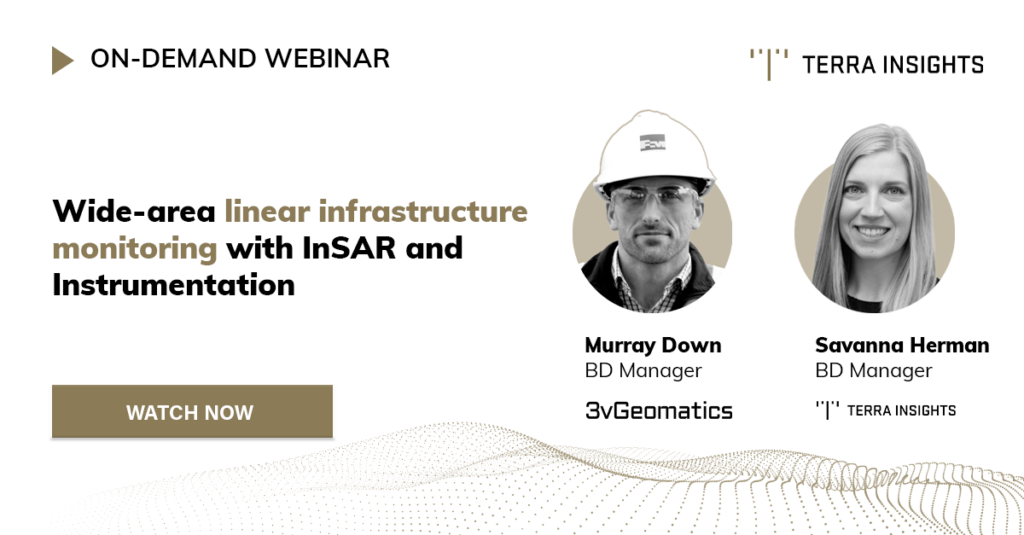Posts by Category
Recent Posts
- RST Instruments joins leading names in monitoring: Introducing Geosolutions
- Leveraging ShapeArray for wireless automated remote deformation monitoring
- United under Orica Digital Solutions, Terra Insights and GroundProbe merge geotechnical technologies and capabilities
- Terra Insights joins Orica, expanding digital solutions platform
- Wide-area linear infrastructure monitoring with InSAR and Instrumentation: Your questions answered
- How to improve blasting practices in mining operations with vibration and air pressure monitoring: Your questions answered
Terra Insights’ Savanna Herman and 3vG’s Murray Down presented Wide-area linear infrastructure monitoring with InSAR and Instrumentation, a webinar that explored multiple real InSAR datasets to demonstrate InSAR’s ability to identify and characterize geohazards that could impact linear infrastructure.

Watch the webinar on-demand to see the entire recording.
The webinar covered:
- Learn the importance of monitoring critical and aging linear infrastructure
- How InSAR can help target your geotechnical instrumentation program for infrastructure projects
- A demonstration of InSAR data sets from real-world infrastructure applications
We received several questions during the webinar. We’ve included some of them along with our answers below.
Q: How do you manage to retrieve non-linear displacement trends?
A: Non-linear displacement trends are a normal thing that we can detect. The most important thing to get non-linear displacements is to have a large volume of data—frequent measurements. The first thing when you’re setting up a program—the most important thing—is to use enough images, which is not always an easy choice because it costs more when you’re using high-resolution data. The number of images has a strong effect on the price you’re going to pay, but it pays off if you are expecting non-linear displacement because then we can measure it more accurately and also measure it earlier.
We can task TerraSAR-X (TSX) to get images at its maximum revisit time, which would be two images per 11-day cycle per look direction. If you max it out with both look directions, then you’re getting 132 images per year. That can make the difference to assume an average every three or so days. Although it will be variable within that period—it’s not consistent every three days—but that can give you an alert more quickly when some non-linear displacement starts. We also have acceleration polygons. They show new areas that are moving more quickly than they were previously.
Q: What is the minimum coherence value you use for InSAR?
A: It becomes difficult to quantify coherence. Even when we can—there are ways to quantify coherence—it varies from pixel to pixel. It varies from data set to data set. It varies for the goals of the project. The short answer is it varies a lot from one data set to another, so the data set that we showed in Sydney, for instance, you’ll notice that even in some of these areas with very minimal vegetation like these grassy fields, we don’t have coverage. That’s a choice in terms of the algorithms that we choose and how we tune it. We’re saying in this case, we’re setting the bar for coherence high to get the very subtle displacement. We don’t really care about the noisy stuff. If we did care about that, we could retune it to set the bar lower for coherence and get measurements there, but it would be noisier. It’s always a trade-off, both in terms of choices of data and in terms of how you tune the algorithm. We always tune that according to the client’s needs whatever they’re looking for.
Q: Does the web application perform the interferometric analysis or only handle the data already processed?
A: Motionary is a data delivery platform. So, the analysis and processing is done through 3vGeomatics and the operations team. Then the reports are delivered through Motionary. So, you can log in and see the up-to-date reports for your sites. The actual InSAR processing is separate from Motionary. We have a huge server farm. It does all the heavy lifting and all the sort of nuanced optimization of the processing. Those InSAR results (which are very different from the raw data) are immediately loaded onto Motionary for consumption by the client in parallel with many other formats that are also delivered. There’s the Structured query language (SQL) database you can open in ArcMap and QGIS. We’ve got a Keyhole Markup Language Zipped (KMZ), and native formats like GeoTIFF. You can also download data straight from Motionary. You can download the whole SQL database and other things from FTP or other formats. You can also download a comma-separated values (CSV) file, just of those points that you select. You can see in Excel, where each point is a row, and each time-period is a column. You can analyze that in other software programs as you wish.
Q: On that displacement plot, can you or do you plot precipitation?
A: The Motionary platform is only for InSAR reports. However, InSAR data can be imported into other types of programs for viewing and data management, data visualization programs, where you can bring in different types of data, like InSAR and weather stations, and other instruments. In those programs you would be able to plot everything or whatever sensors you want together or view the InSAR data over certain areas of the site and overlay everything. Something like NavStar’s GeoExplorer would bring in different types of data to view together in there.
We can also bring in certain types of layers into Motionary as well, however, currently you can’t load them on the fly. If you send them to us, we can build in separate layers. It’s easier to use one of the other formats that we deliver in parallel.
This transcript has been edited for clarity. Watch the webinar on-demand to learn how vibration and air pressure monitoring can improve blasting practices.
Speak with an Expert
I’m very happy with the quality of the instrumentation and technical support from RST, as always. They worked with us from the initial stages of the project to ensure that we were fully prepared and equipped to use the RSTAR network for the first time. They delivered everything within the tight project time frame to ensure that there were no delays on site, and the submersible tilt meters looked like new even after over twelve months of being submerged in Thames water!
-Richard Lipscombe, BEng (Hons), Director & Principle Consultant - RL Geotechnical Ltd
Related Posts
Leveraging ShapeArray for wireless automated remote deformation monitoring
Wireless automated remote deformation monitoring is transforming how engineers collect dat...
ShapeArray Fundamentals in 2023: Your questions answered
Measurand’s Mitchell Pollock and Terra Insights’ Josh Smith presented ShapeArray™ Fu...
Meet RSTAR Affinity
Critical asset data at your fingertips Designed by RST’s team of instrumentation experts...







